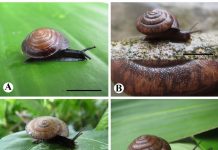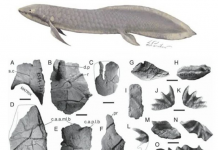Assistant Professor Dr Chanidaporn Tumpeesuwan and Assistant Professor Dr Sakboworn Tumpeesuwan, researchers from the Department of Biology, Faculty of Science, Mahasarakham University, and their colleagues, have discovered eight new species of land snails from 2014 to 2019. They are as follows:
Phuphania costata Tumpeesuwan & Tumpeesuwan, 2014 (หอยทากภูพานเปลือกร่อง)
Phuphania costata sp. nov. is described from Phu Pha Lom limestone area, Loei Province, Northeastern Thailand. Morphological features were examined and compared with Phuphania globosa Tumpeesuwan, Naggs & Panha 2007 and other species belonging to related genera. It is hypothesized that a decrease in the number of clusters of the internal ducts in the amatorial organ gland, and a thickening of the sac of the amatorial organ gland in P. costata are derived characters in the genus Phuphania. The geographically disjunct distributions of P. globose and P. costata may be a result of dry climatic conditions during the Pleistocene, leading to allopatric speciation in Phuphania.
Tumpeesuwan, Chanidaporn & Sakboworn Tumpeesuwan. 2014. Phuphania costata, a new species of dyakiid land snail (Pulmonata: Dyakiidae) from Phu Pha Lom limestone area, Loei Province, northeastern Thailand. Raffles Bulletin of Zoology 62: 352-357.

Pearsonia lamphunensis Tumpeesuwan & Tumpeesuwan, 2015 (หอยงวงท่อลำพูน)

A new cyclophorid species of the genus Pearsonia possessing a sub-discoidal shell with a sutural tube was discovered from a dolomitic limestone hill in Lamphun Province, northern Thailand. This discovery also represents the first record of the genus in Thailand. Pearsonia lamphunensis, new species, differs from the related congeners by the zig-zag brown stripes that are present on both dorsal and ventral sides of the shell. The radula morphology of the genus Pearsonia is examined for the first time. The central cusps of both central and lateral teeth are shovel-shaped, and the central cusp’s width is more than half that of the tooth’s width. Comparisons of the radula morphology of Pearsonia lamphunensis, new species, and the recently described Pterocyclos diluvium Sutcharit & Panha in Sutcharit et al., 2014, suggest that Pearsonia is more closely related to Pterocyclos than Rhiostoma, which has fewer cusps in the outer lateral teeth and thus differs from both aforementioned genera.
Tumpeesuwan, Sakboworn & Chanidaporn Tumpeesuwan. 2015. First record and description of a new species of the land snail genus Pearsonia Kobelt, 1902 (Cyclophoridae: Pterocyclinae) from Thailand, with a note on radula morphology. Raffles Bulletin of Zoology 63: 287-292.
Sinoennea loeiensis Tanmuangpak & Tumpeesuwan, 2015 (หอยทากจิ๋วนักล่าเมืองเลย)
A new species of carnivorous microsnail is described from Phu Pha Lom Limestone Hill in Loei Province, Northeastern Thailand. Sinoennea loeiensis, new species, has a minute, ovoid-cylindrical shell. The external shell surface is rather smooth, glassy, transparent, and shiny. Six apertural teeth are present, including one parietal, two palatal, one basal, and two columellar teeth. Reproductive anatomy of the new species differs from Sinoennea kanchingensis by its shorter gametolytic sac, vas deferens entering the penis subapically, and vagina shorter than oviduct. The radula comprises 42 rows of teeth, which are arranged in V-shape rows, and contains 19–21 teeth each. This is the first record of a diapherid microsnail in northeastern Thailand.
Tanmuangpak, Kitti, Dumrongrojwattana, Pongrat, Tumpeesuwan, Chanidaporn & Tumpeesuwan, Sakboworn, 2015, Sinoennea loeiensis, a new species of diapherid microsnail (Pulmonata: Streptaxoidea: Diapheridae) from Phu Pha Lom Limestone Hill, Loei Province, Northeastern Thailand, Raffles Bulletin of Zoology 63, pp. 293-300

Sesara triodon Tanmuangpak & Tumpeesuwan, 2017 (หอยแก้วน้อย)

Sesara triodon n.sp. is described from the Phu Pha Lom limestone area in Loei, northeastern Thailand. It possesses a small and depressed–conoid, transparent shell with a shiny external surface. The aperture possesses three apertural teeth, in contrast to other Thai species, Sesara parva Solem, 1966 (two teeth) and Sesara megalodon Blanford, 1902 (four teeth). The genital system of the new species has some distinctive characters, including a vagina longer than the free oviduct, and the epiphallic retractor caecum is rounded and bulbous. The radula has 104 rather straight rows of teeth, with each row having74–81 teeth. This is the easternmost record of the genus Sesara in Thailand.
Kitti Tanmuangpak, Chanidaporn Tumpeesuwan & Sakboworn Tumpeesuwan (2016): A new species of Sesara Albers, 1860 from northeastern Thailand (Stylommatophora: Helicarionidae), Molluscan Research, DOI: 10.1080/13235818.2016.1155431
Aenigmatoconcha clivicola Tumpeesuwan & Tumpeesuwan, 2017 (หอยทากพิศวงเมืองเลย)
Aenigmatoconcha clivicola, new genus and new species, was described from a limestone hill in Loei Province, northeastern Thailand. Morphological features of the shell, genital system, and radula were examined and compared with Sophina calias and S. schistostellis from Southeastern Myanmar, and Chalepotaxis infantilis from Southern China. It differs from all previously described Sophina species due to its more flattened and depressed, thin glossy shell, and its soft parts possessing broad right and left mantle shell lobes. The radula comprises approximately 20–25 transverse V-shaped rows of teeth; each row having 17–137 unicuspid spatulate teeth. The genital system lacks an amatorial organ and has a very large cylindrical penis without a penial sheath.
Tumpeesuwan, Chanidaporn & Tumpeesuwan, Sakboworn, 2017, Discovery of an overlooked Helicarionid land snail (Helicarionidae: Durgellinae) from northeastern Thailand, with description of a new genus and new species, and note on radula morphology and genital system, Raffles Bulletin of Zoology 65, pp. 181-188

Aenigmatoconcha sumonthai Tumpeesuwan & Tumpeesuwan, 2018
(หอยทากพิศวงคุณมนตรี)

Aenigmatoconcha sumonthai, new species, is described from Tham Chang Phueak, a limestone range in Chumphon province, southern Thailand. The external morphology of the shell and soft parts, the genital system, and radula morphology were examined and compared with the type species of the genus, A. clivicola C. Tumpeesuwan & S. Tumpeesuwan, 2017 from northeastern Thailand. Externally the new species differs from A. clivicola in having a smaller shell, presence of black bands from the base of the long tentacles to the mantle edge, and both mantle shell lobes have numerous tiny white spots and irregular black marbling. The radula comprises approximately 22–35 transverse v-shaped rows of teeth, with each row having 11–150 unicuspid spatulated teeth. In the genital system, the penis is longer than the epiphallus and the base of the gametolytic sac is longer than the middle part.
Tumpeesuwan, C. & Tumpeesuwan, S. (2018). Aenigmatoconcha sumonthai, a new helicarionid land snail from Chumphon Province, Southern Thailand (Helicarionidae: Durgellinae). Raffles Bulletin of Zoology. 66: 170–176.
Landouria strobiloides Tumpeesuwan & Tumpeesuwan, 2019 (หอยกระดุมเปลือกสัน)
A new species of land snail is described from the Suan Hin Pha Ngam Limestone Area in Loei Province, northeastern Thailand. This species is placed in the genus Landouria Godwin-Austen, 1918 based on the presence of a slightly long club-shaped flagellum with variably sized tubercles, a gametolytic sac with swollen basal part, and absence of dart sacs and mucous glands. This is the first verified record of the genus Landouria in Thailand.
Chanidaporn Tumpeesuwan and Sakboworn Tumpeesuwan. 2019. First Verified Record of the Genus Landouria Godwin-Austen, 1918 from Thailand (Gastropoda: Stylommatophora: Camaenidae) with Description of A New Species. RAFFLES BULLETIN OF ZOOLOGY. 67; 298–305.

Muangnua arborea Tumpeesuwan & Tumpeesuwan, 2019 (ทากลดเปลือกเกาะใบ)

Muangnua arborea Tumpeesuwan & Tumpeesuwan, sp. nov., is described, based on specimens deposited in the land snail collection of Mahasarakham University, Thailand. This species is the second described in the genus Muangnua, for which colour pictures of the living semislug in natural habitats, scanning electron microscope photos of the radula, and anatomy of the mature specimens were studied and presented for the first time for this genus. Keys to genera of Southeast Asian slug-like semislugs and species of Muangnua are provided.

Tumpeesuwan C, Tumpeesuwan S (2019) Muangnua arborea, a new semislug (Gastropoda, Stylommatophora, Helicarionidae, Durgellininae) from Loei Province, northeastern Thailand. ZooKeys 894: 19–32. https://doi. org/10.3897/zookeys.894.38327







